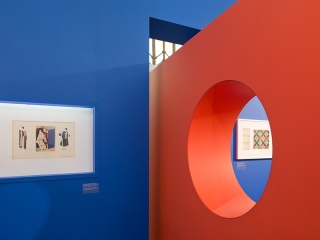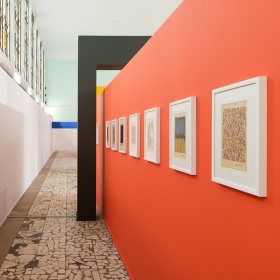Original sketches, samples of fabrics, photographs, posters, costumes and fashion magazines showcased four decades of textile and fashion design in the Soviet Union. The Grain Pavilion at VDNKh, the vast Soviet era trade fair hosted the event.
The exhibition was laid out in chronological order, beginning with suprematist and constructivist works of the early 1920s, with pieces by Varvara Stepanova, Liubov Popova and Kazimir Malevich among others. In the mid 1930s suprematist designs gave way to propaganda. Prints were filled with the pathos of revolutionary events and subsequent achievements of socialism. Important moments in Soviet history were recorded on shawls and scarves. In the 1940s and 50s Soviet cotton chintz, staple and crepe de chine bore optimistic prints, where small flower bouquets, delicate colours and the legendary polka dot prevailed. The last section of the exhibition was devoted to the search for new design solutions in the 1960s. Textile schools of this period looked back to the historical avant-garde for inspiration and experimented with collage techniques.
Bold interweaving volumes defined the exhibition design in direct reference to the subject of fabric; its structure, patterning and subsequent formation of garments. The complex geometry allowed the visitor to experience continually evolving compositions of form, colour & pattern as one moved through the space.
Bright background played a crucial role in drawing the eye to small, dainty fabric samples and drew together various ensembles of clothing and sculpture.
Design: Olga Treivas, Very Odyn, Darya Sheina, Elena Kornilova
Client: VDNKh
Curator: Daria Makarova
Project Status: completed
Location: VDNH , Grain Pavilion
Area: 1000 m2
Year: 2015
Photography: Ilya Ivanov
Экспозиция объединит больше ста экспонатов из собраний профильных российских музеев, архивов и частных коллекций.
Важные для советской истории моменты фиксировались на агитационных платках, вошедших в ассортимент крупнейших текстильных фабрик.
В
1940–1950 -х годах на отечественном ситце, штапеле и крепдешине преобладал оптимистичный рисунок в виде мелких цветочных букетиков нежных расцветок и легендарного горошка.Последний блок выставки связан с поисками новых дизайнерских решений
1960-х .




















